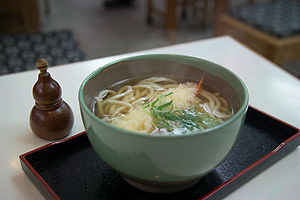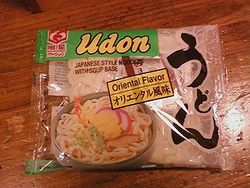Udon


Udon (饂飩, usually written as うどん) is a type of thick wheat-flour noodle popular in Japanese cuisine.
Udon is usually served hot as noodle soup in a mildly flavoured broth, in its simplest form as kake udon, served in kakejiru made of dashi, soy sauce (shōyu), and mirin. It is usually topped with thinly chopped scallions. Other common toppings include tempura, often prawn or kakiage (a type of mixed tempura fritter), or abura age, a type of deep-fried tofu pockets seasoned with sugar, mirin, and soy sauce. A thin slice of kamaboko, a halfmoon-shaped fish cake, is often added. Shichimi can be added to taste.
The flavor of broth and topping vary from region to region. Usually, dark brown broth, made from dark soy sauce (koikuchi shōyu) is used in eastern Japan, and light brown broth, made from light soy sauce (usukuchi shōyu) is used in western Japan. This is even noticeable in packaged instant noodles, which are often sold in two different versions for east and west.
Contents |
Origin
In China, similar thick wheat flour noodles are called cū miàn (粗麵). This original udon was was 2 to 3 cm in diameter, a flat pancake-shaped "noodle" added to miso-based soup. The Japanese character 饂飩 is easily confused with and different from the modern Chinese characters characters 餛飩, which refers to wonton dumplings, not noodles. In Chinese, udon is called 烏冬 wūdōng or 烏冬麵 wūdōngmiàn, sometimes 烏龍麵 wūlóngmiàn. (Note that this is unrelated to Oolong tea, 烏龍茶 wūlóngchá.)
The origin of udon in Japan is credited to Buddhist priests who traveled to China: local areas specifically attribute Kūkai or Enni. Kūkai, a Buddhist priest, traveled to China around the beginning of the 9th century to study Buddhism. Sanuki Province claimed to have been the first to adopt udon from Kūkai. Enni, a Rinzai Zen monk, went to China in the 13th century; Hakata claimed to have produced udon based on Enni's recipe.
Common udon dishes



Like many Japanese noodles, udon noodles are served chilled in the summer and hot in the winter. Toppings are chosen to reflect the seasons and to balance with other ingredients. Most toppings are added without much cooking, although some are deep-fried. Many of these dishes may also be prepared with soba.
Hot
- Kake udon (in Kantō) or Su udon (in Kansai): Hot udon in broth topped with thinly sliced green onions, and perhaps a slice of kamaboko.
- Kitsune udon: "Fox udon". Topped with Aburaage (sweetened deep-fried tofu pockets). A favorite in the Kansai region, particularly Osaka.
- Tempura udon : Topped with tempura, especially prawn, or kakiage, a type of mixed tempura fritter.
- Tanuki udon ("Raccoon-dog udon") (in Kantō) or Haikara udon (in Kansai): Topped with tenkasu (deep-fried tempura batter).
- Tsukimi udon: "Moon-viewing udon". Topped with raw egg, which poaches in the hot soup.
- Wakame udon: Topped with wakame, a dark green sea vegetable.
- Karē udon: "Curry udon". Udon in a soup made of Japanese curry. May also include meat or vegetables.
- Chikara udon: "Power udon". Topped with toasted mochi rice cakes. A hearty dish.
- Stamina (sutamina) udon: "Stamina udon". Udon with various hearty ingredients, usually including meat, a raw egg, and vegetables.
- Nabeyaki udon: A sort of udon hot-pot, with seafood and vegetables cooked in a nabe, or metal pot. The most common ingredients are tempura shrimp with mushrooms and an egg cracked on top.
- Kamaage udon: Served in a communal hot-pot with hot water, and accompanied by a hot dipping sauce of dashi and soy sauce.
- Udon-suki: Udon cooked in the manner of sukiyaki.
- Yaki udon: Stir-fried udon in soy-based sauce, prepared in a similar manner to yakisoba. This originated in Kitakyushu of Fukuoka Prefecture. (Note that while yakiudon is made with udon, yakisoba is not made from buckwheat soba, but with steamed Chinese-style ramen.)
- Misonikomi udon: Hard udon noodles simmered in red miso soup. The soup generally contains chicken, a floating cracked raw egg that is stirred in by the eater, kamaboko, vegetables and tubers. The noodles are extremely firm in order to stand up to the prolonged simmering in the soup; additionally, the noodles do not contain salt, so as to avoid over-salting from the salt in the miso.
- Houtou udon: a local dish of Yamanashi Prefecture, a type of miso soup with udon and plenty of vegetables.
Cold
- Zaru udon: Chilled udon noodles topped with shredded nori and served on a zaru (笊 or ざる), a sieve-like bamboo tray. Accompanied by a chilled dipping sauce, usually a strong mixture of dashi, mirin, and shoyu. Eaten with wasabi or grated ginger.
- Bukkake udon: Cold udon served with various toppings liberally sprinkled on top. It may include:
- kijoyu udon: served in a cold soup of raw (unpasteurized) soy sauce and sudachi (a type of citrus) juice, sometimes with a bit of grated daikon
Regional varieties
There are wide variations in both thickness and shape for udon noodles.
- Biei-style Curry (カレー): udon from Biei, Hokkaido.
- Inaniwa (稲庭): a thin type from Akita Prefecture.
- Ise (伊勢): udon from Mie Prefecture.
- Kansai (関西): udon is a soft type of medium thickness from the Kansai region.
- Kishimen (棊子麺, or more commonly きし麺): is a flat type from the Nagoya area.
- Sanuki (讃岐): udon is a thick and rather stiff type from Kagawa Prefecture.
- Hōtō (rarely 餺飥, commonly ほうとう): a flat and wide type, usually cooked with vegetables, particularly Japanese "kabocha" squash, from Yamanashi Prefecture.
- Dangojiru (団子汁): similar to the above Hohtoh, from Ōita Prefecture. Nominally a "dumpling soup", it resembles very thick, flat udon.
- Okinawa soba (沖縄そば): also called suba, a regional Okinawan noodle made by adding some vegetal ash to the flour, similar to how ramen is made. However, it is very similar to udon.
- Udon is also popular in South Korea, where it is called udong (우동) [udoŋ].
- There is also a dish called udon in Palau, because of the former Japanese administration. The broth is soy sauce–based like Japanese udon. However, as there were many immigrants from Okinawa, it uses less broth like Okinawa soba. Most notably, the noodle is that of spaghetti, as it is easier to acquire there.
See also
- Thick noodles, a very similar variety of noodle from China
- Soba
- Somen
- Ramen
- Japanese noodles
References
- Tsuji, Shizuo. (1980). Japanese cooking: A simple Art. Kodansha International/USA, New York.